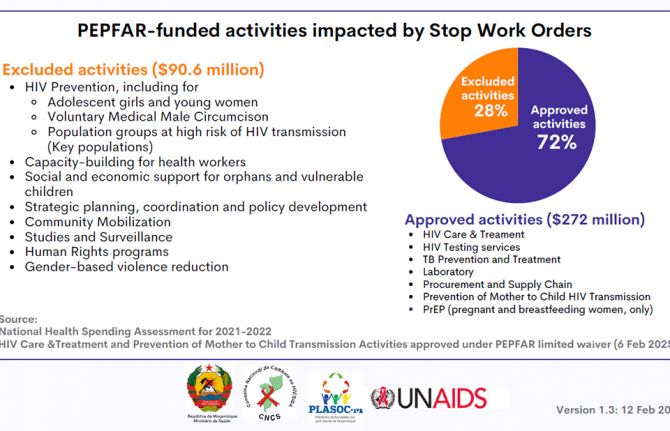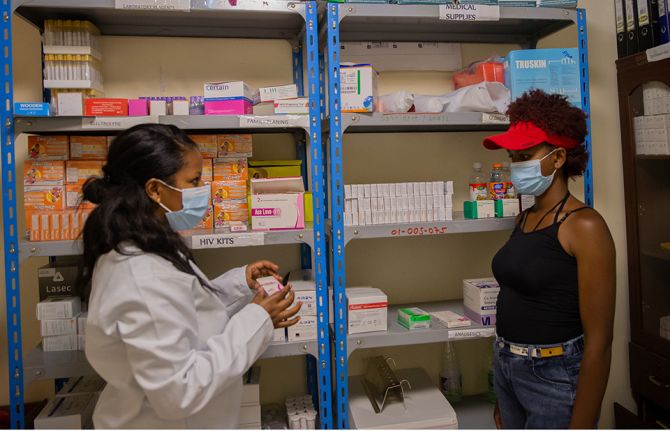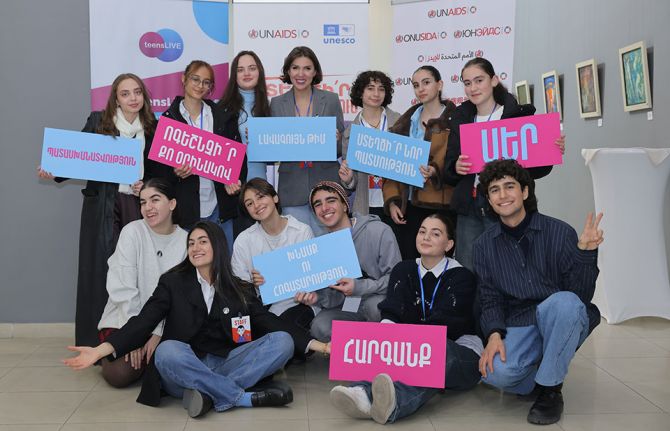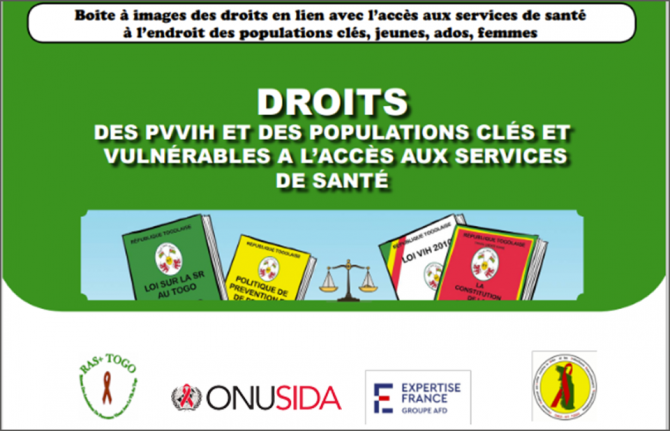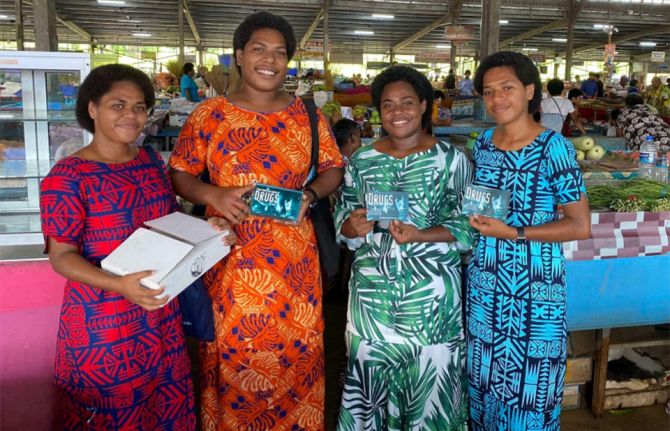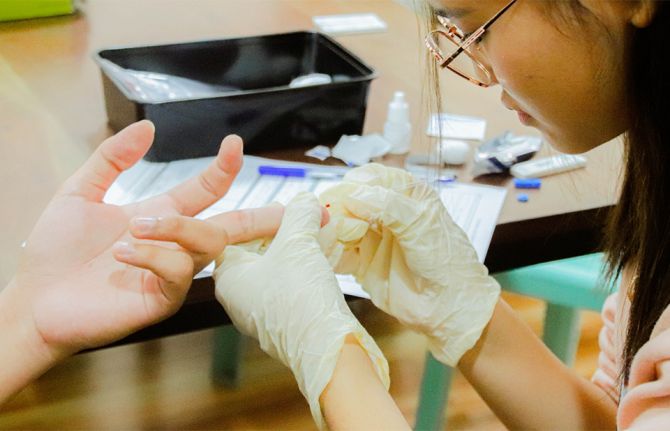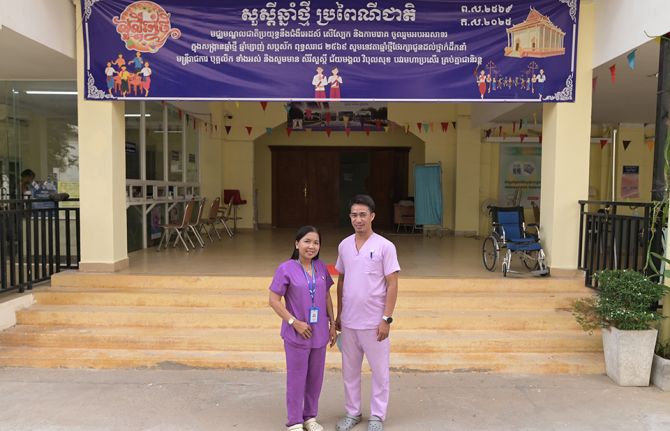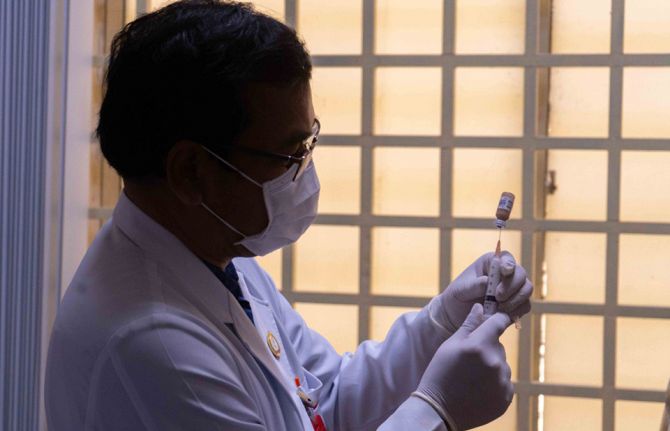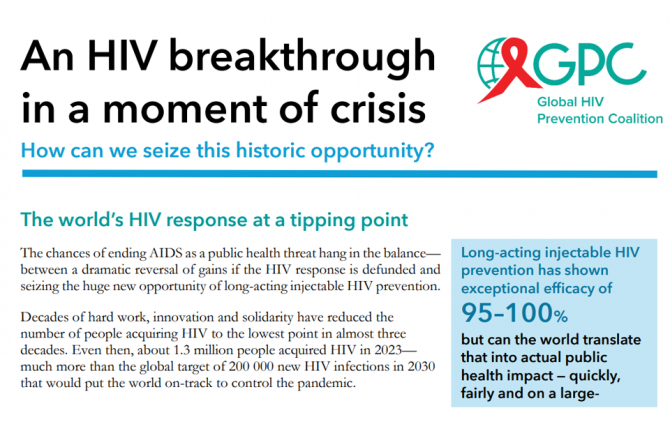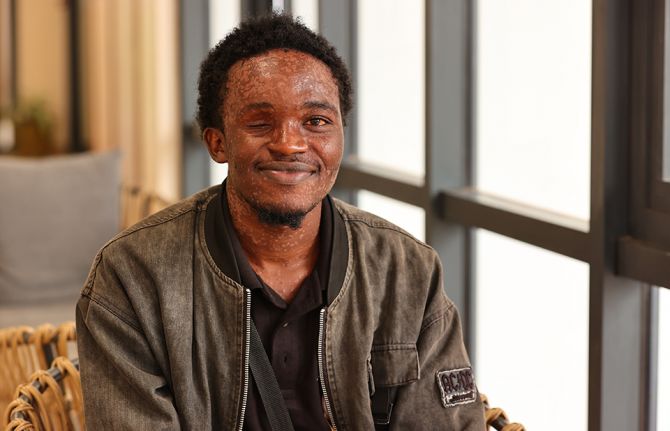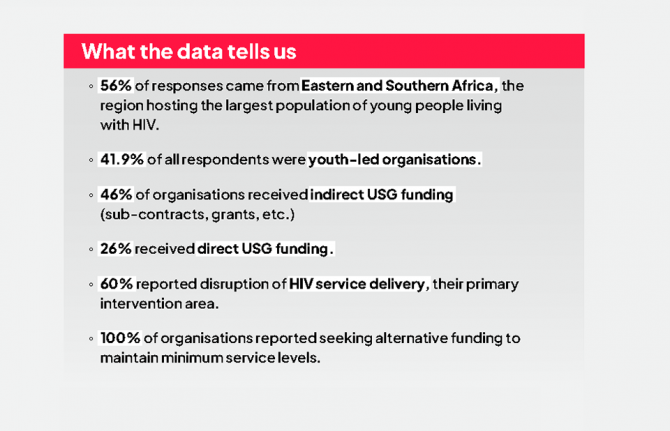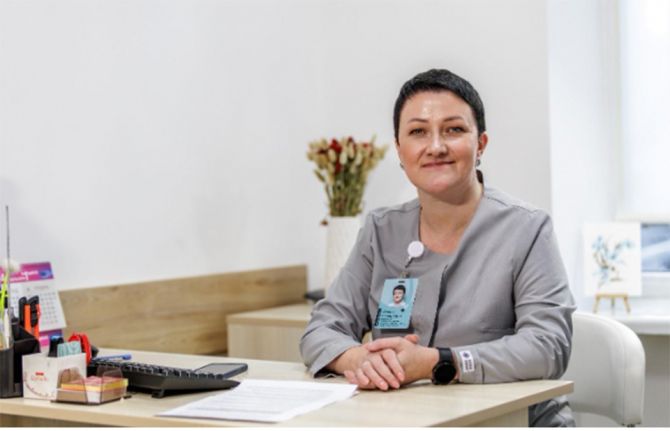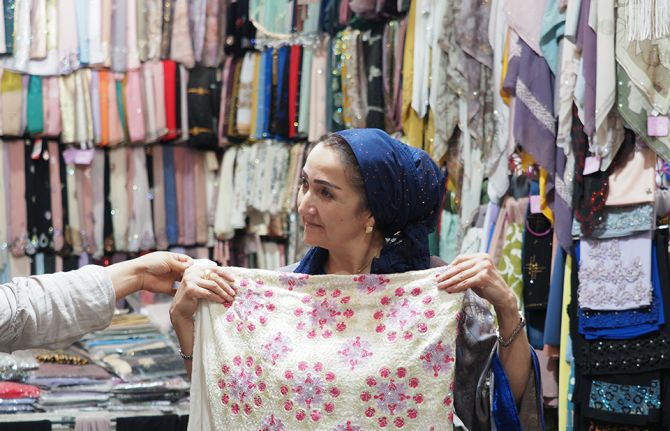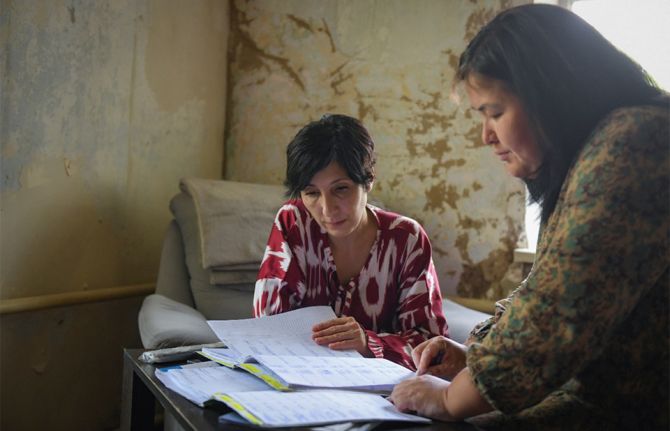
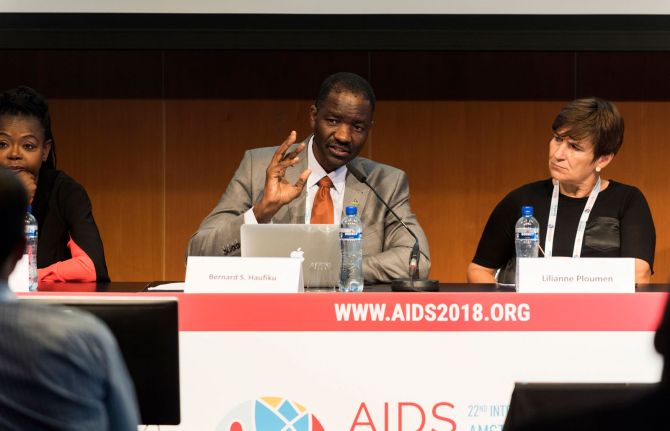
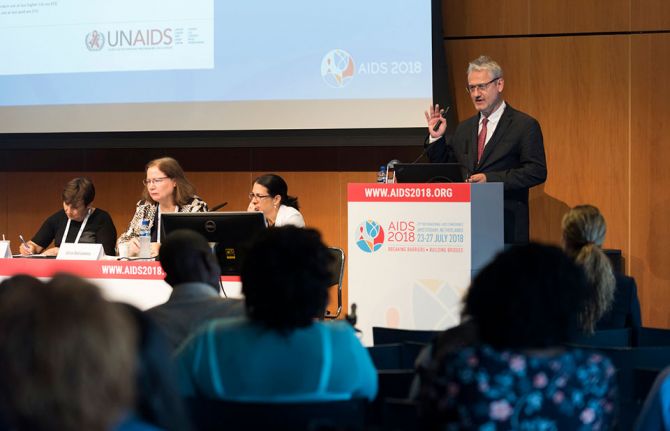

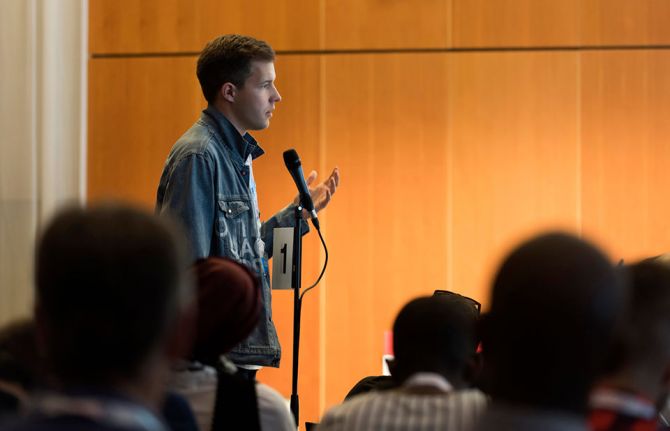
Update
A condom crisis at the centre of the HIV prevention crisis
28 July 2018
28 July 2018 28 July 2018HIV and other sexually transmitted infections and unintended pregnancies continue to pose a high health burden for millions of people, especially young women and key populations.
Data presented during a session of the 2018 International AIDS Conference, held in Amsterdam, Netherlands, from 23 to 27 July, entitled Condoms 2.0: Reinvigorating Effective Condom Programming in the Era of Epidemic Control, shows that condom promotion has averted an estimated 50 million new HIV infections since the onset of the HIV epidemic. Condom use at last higher-risk sex has increased over the past three decades in most countries across the world and is as high as 80–90% in some countries. Furthermore, in all countries for which data are available, a steady decrease in new adult HIV infections between 2000 and 2016 is associated with steady increases and high levels (more than 60%) of condom use by both men and women at last sex with a non-regular partner and condom use by men at last paid sex.
However, 30 years into the response to HIV and despite the increased use of condoms over the past three decades, condom availability and use gaps remain, in particular in sub-Saharan Africa, where the gap between availably and need is estimated to be more than 3 billion condoms. The estimated condom need in 47 countries in sub-Saharan Africa in 2015 was 6 billion male condoms; however, only an estimated 2.7 billion condoms were distributed.
The participants highlighted the many barriers and inequities hindering access to, and the use of, condoms that continue to exist, including poor access, age restrictions, gender norms, religious norms, stigma, insufficient supply and, in some places, laws that make it an offence to carry condoms. Many countries also prohibit condom promotion and distribution in schools and other venues where adolescents socialize. According to the participants, of the 100 countries that reported having a national plan or strategy related to condoms in 2017, only 26 reported that the plan included condom promotion in secondary schools.
International funding for condom procurement in sub-Saharan Africa has decreased in recent years, and domestic funding has not sufficiently increased, the participants noted. In several countries condom programming, in particular condom promotion and demand creation, has stalled due to a lack of funding and decreased investment.
During the session, the participants stressed the need for a new generation of comprehensive, data-driven and people-centred condom programmes as part of the delivery of combination HIV prevention and sexual and reproductive health services for people at higher risk of HIV and other sexually transmitted infections and unintended pregnancies.
These new programmes should aim at strengthening demand for and supply of condoms and lubricants and address the barriers and inequities that hinder the demand for and the provision, access and use of condoms by young people, key populations and other people at higher risk of HIV. Furthermore, condom promotion and distribution strategies and approaches need to be informed by data, tailored to the context and needs of different communities.
Lastly, the participants agreed on the need to set up effective multistakeholder condom programming coordination and oversight platforms and ensure the full involvement of beneficiaries and communities in planning, service delivery and monitoring.
Quotes
“There is a condom crisis at the centre of the prevention crisis. We are missing a cost-effective opportunity to maximize the contribution of condoms to reducing HIV infections, other sexually transmitted infections and unintended pregnancies.”
“We need to recapture lost ground. That means do business not as usual.”
“Not even for a million euros I would accept to do it with a client without a condom.”
Related resources
Related

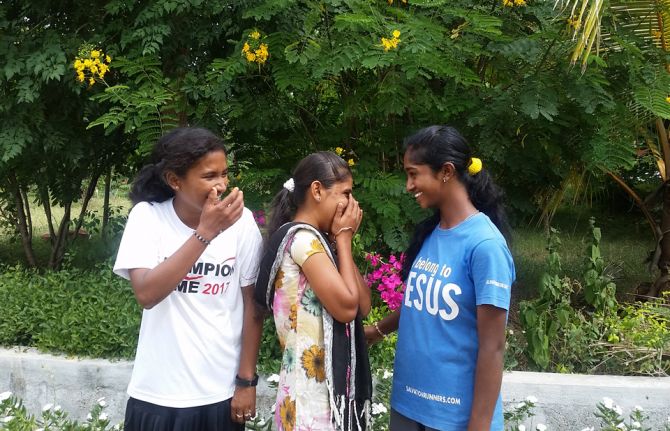
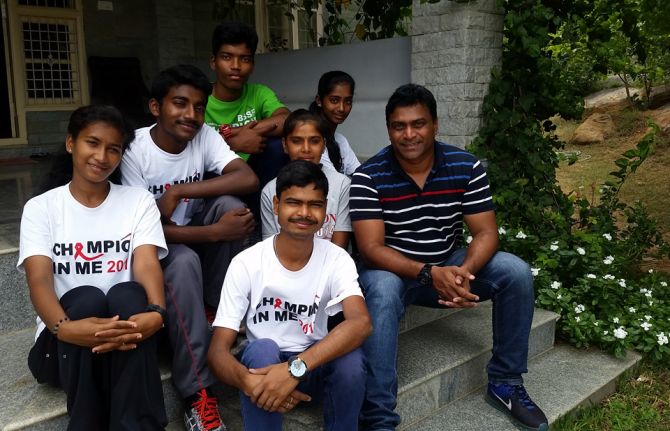

Feature Story
Running Positive: zero discrimination against adolescents living with HIV in India
24 July 2018
24 July 2018 24 July 2018As the dark monsoon clouds give way for the sun, yellowish crimson rays fall on Ambika’s face. She squints and continues to intently inspect the lush green lettuce she is growing in her backyard. The 17-year-old is living with HIV and lost both her parents to AIDS. With a glint in her eyes and a perpetual smile, she casually mentions that she likes to run in the mornings. Later, her coach proudly reveals that she is a 10-kilometre runner and is preparing to participate in the next Durban Marathon. Her friends Ashwini and Bhawani, aged 18 and 16 years, both living with HIV and 10 km runners themselves, proudly mention that, “Ambika won the Bangalore Ultra run. It was 12.5 km!”
These young women are a part of an initiative called Champion in Me that uses sport to respond to stigma and discrimination against adolescents living with HIV. Based in Bangalore, the programme uses running as a medium to empower them and strengthen their belief in themselves. Today, almost 200 children living with HIV are part of the programme, and it continues to expand. They live as a family together in the premises of Snehagram, an organization located in Tamil Nadu. Aimed at meeting the needs of adolescents living with HIV, the programme provides long- and short-term opportunities for academic learning and vocational skill development.
Manik and Babu, both 18 years old, are part of Champion in Me. They have participated in more than 20 runs, including at events such as the International Children’s Games in the Netherlands, the IDBI Marathon in New Delhi and the Boston Marathon. Their journey, challenges and experiences have been documented in Running Positive, a film screened at the International AIDS Conference, being held in in Amsterdam, Netherlands, from 23 to 27 July.
Manik said, “This film will motivate you to question the conventional image of an HIV-positive individual in India and the treatment meted out to them.” Babu explains that the film sheds light on how sports can be used to mainstream a segment of society that is vulnerable and discriminated against.
Their elated coach, Elvis Joseph, said, “I have champions who are running not just for themselves, but for all their friends who are living with HIV.”
“These young people living with HIV have inspired all of us. They have now documented their lives in this touching movie,” said Bilali Camara, UNAIDS Country Director for India.
Region/country

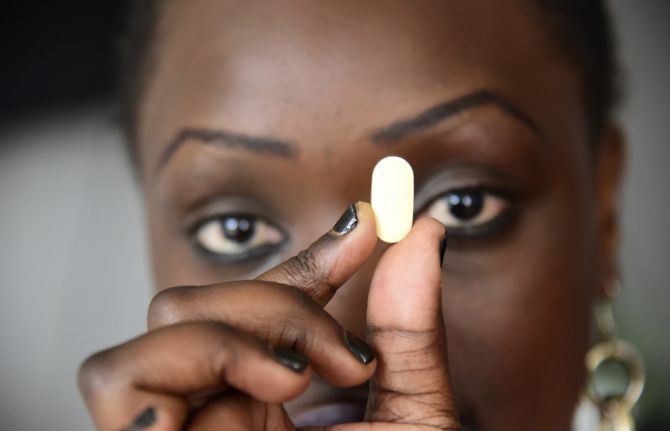
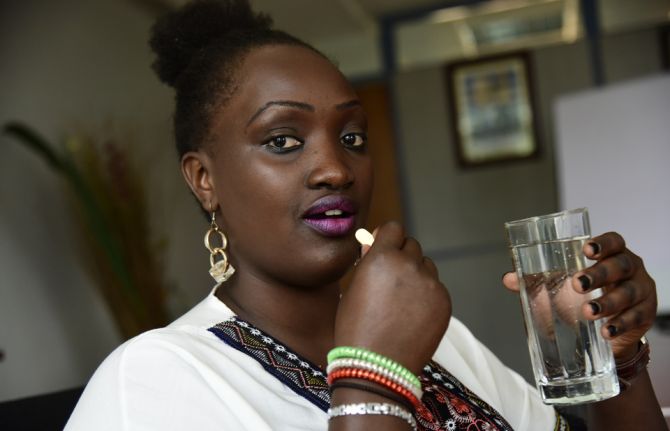
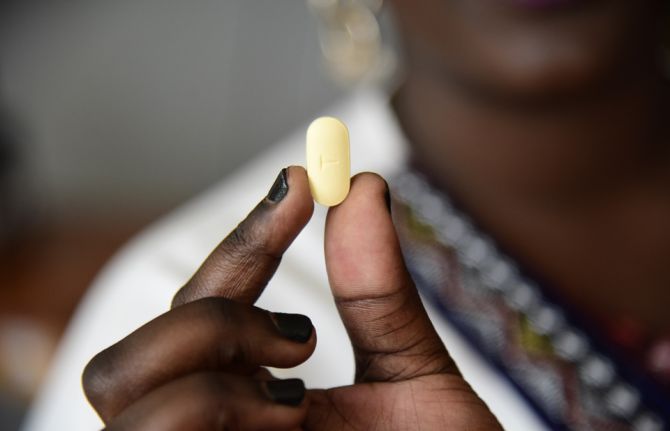
Feature Story
How HIV treatment numbers are shown to be accurate
26 July 2018
26 July 2018 26 July 2018Estimating how many people living with HIV are on treatment is vital to keeping track of the success or otherwise of the global AIDS response. HIV treatment not only keeps people alive, but, through reducing the viral load of a person, greatly reduces the chance that a person living with HIV will transmit the virus to someone else.
UNAIDS published its latest estimates of the number of people living with HIV accessing antiretroviral therapy in its new report, Miles to go. An estimated 21.7 million [19.1–22.6 million] people of the 36.9 million [31.1–43.9 million] people living with HIV at the end of 2017 were on HIV treatment.
A total of 143 countries submitted the data that UNAIDS used to compile the estimate, representing 91% of all people estimated to be on treatment worldwide. Those 143 countries supply actual counts of people on treatment, not estimates, although estimates are used for those few countries that do not supply counts. Countries report their numbers of people on treatment—both adults and children, disaggregated by sex—through the Global AIDS Monitoring tool every six months. Similar data are included in the Spectrum epidemiological estimation software.
UNAIDS provides technical assistance and training to public health officials and clinical officers—the people who compile the numbers in the countries—to ensure that their reports on treatment coverage are accurate. In addition, every year, in partnership with the United Nations Children’s Fund, the World Health Organization and other partners that support the delivery of HIV treatment services, UNAIDS reviews and validates the treatment numbers reported through both the Global AIDS Monitoring tool and Spectrum.
When UNAIDS’ estimates of treatment coverage in countries are compared with estimates of treatment coverage made in Population-Based HIV Impact Assessments (PHIA) and other surveys, similar levels of treatment coverage are seen (see the attached graph).
In 2017, UNAIDS carried out a triangulation of data as a way to confirm or deny the results of its annual data collection. That analysis sought to answer a simple question: are enough antiretroviral medicines produced and bought to treat the number of people reported to be on antiretroviral therapy?
At the end of 2016, 19.4 million people globally were on antiretroviral therapy, with an estimated 14.1 million people accessing treatment in generic-accessible low- and middle-income countries.
A study of the exports and domestic procurement of antiretroviral medicines in 2016 from India showed 11.4 million person-years of treatment. When the generic antiretroviral medicines produced in other countries were included, an estimate of 14.2 million–16.2 million person-years on treatment was made—sufficient to treat the 14.1 million people in generic-accessible low- and middle-income countries.
In 2018, UNAIDS partnered with the World Health Organization, the Global Fund to Fight AIDS, Tuberculosis and Malaria and selected technical partners and ministries of health in 28 countries, most of which are in sub-Saharan Africa, to conduct data quality reviews of reported treatment numbers and, where over- or undercounting is found, to correct current and historical reports of treatment numbers. Previous data quality reviews since 2016 have been used to adjust estimates, for example by taking into account people who transfer from one clinic to another, but are reported by both clinics, or people who have died, left care or emigrated but are not identified and removed from treatment registries.
More details on the methods for calculating the number of people on treatment can be found in the annex on the methods in Miles to go, while details of how the triangulation was undertaken can be found in a publication published on an earlier triangulation exercise.
Related

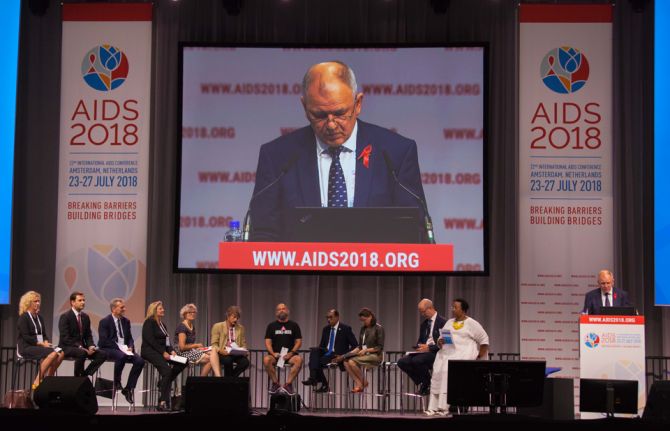
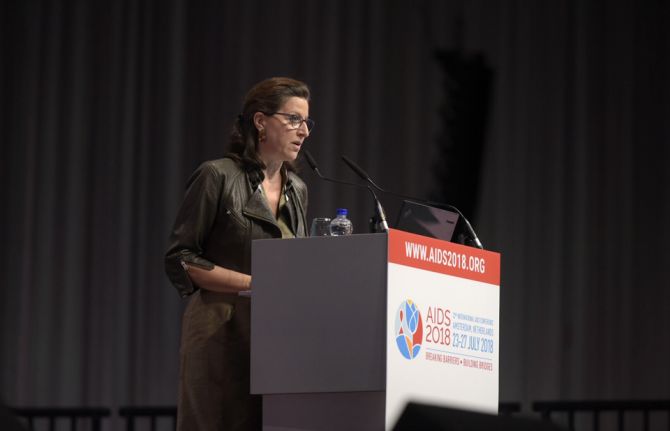
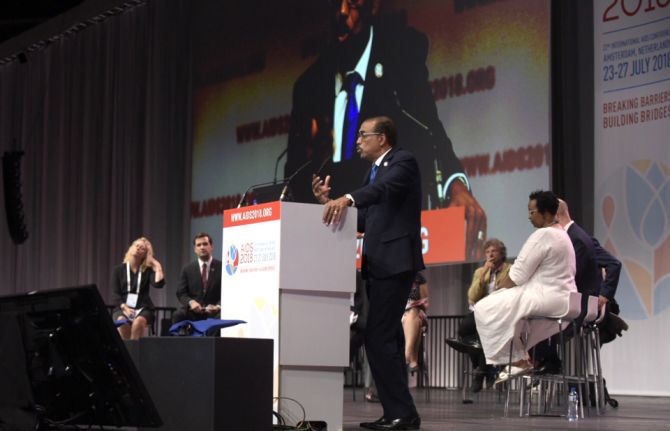
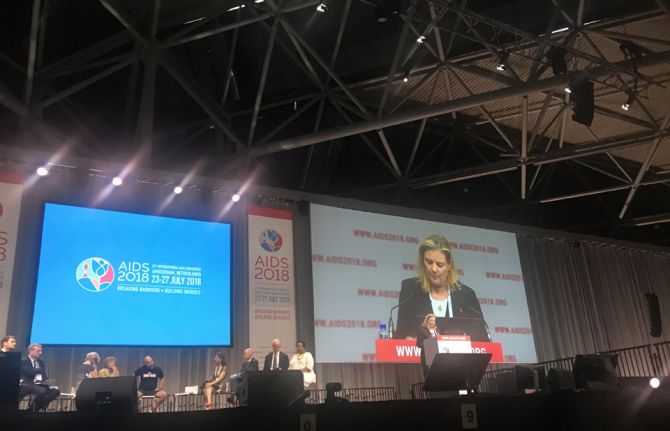
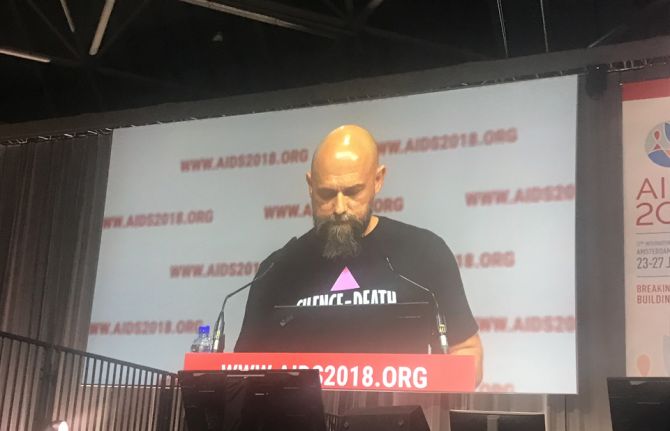
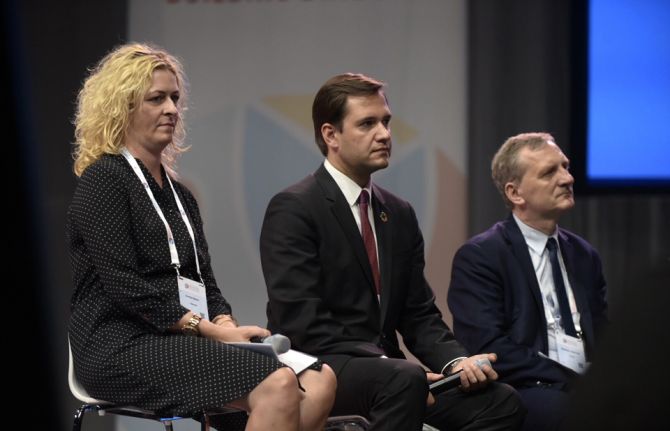
Feature Story
Reaching the 10-10-10 will put Europe on track to achieving the SDG targets
25 July 2018
25 July 2018 25 July 2018European Union political leaders met to discuss the successes, challenges and future priorities for addressing HIV in Europe at ministerial meeting in the margins of the 2018 AIDS conference.
The session started with a powerful appeal from the European civil society co-chair Esther Dixon-Williams (European AIDS Treatment Group) to ensure people living with HIV and key populations remain central to the discussions in keeping with the call from the inception of the AIDS response “nothing about us without us”.
A few European Union (EU) countries are on track to reach the 90-90-90 goals, however to reach the target of ending AIDS by 2030 and leaving no one behind, increased efforts to reach out to men who have sex with men, transgender people, migrants, sex workers, people who inject drugs and people in detention are needed.
The rising epidemic among men who have sex with men in central and south eastern Europe was highlighted as well as the continuing emergency for people who use drugs in the eastern European states. HIV-related stigma and the criminalisation of people who use drugs, sex workers, MSM, transgender people are major obstacles to seeking, accessing or staying on treatment. Understanding this stigma and reducing it should be a key priority in the months and years ahead for the European Union institutions and its EU member states. Civil Society drew attention to the Ljubljana Declaration 2.0, a call for urgent action in response to rapidly expanding HIV epidemics among gay men, other men who have sex with men and trans people in newer EU member states and enlargement countries
Important announcements were made by Germany, France and the Netherlands highlighting that increasing demand and making pre-exposure prophylaxis (PREP) available and reimbursed nationally for all is a priority within the next months. It was highlighted that Europe needs to do more to ensure the right to health of migrants is respected. Migrants must be protected from increased vulnerability to HIV to access needed health services regardless of residency or insurance status and that they are not returned to countries where there is no real access to treatment.
The ministerial meeting provided an opportunity to showcase the tremendous contribution European Union member states countries and the European Commission have made to the AIDS response globally and within their own borders. Participants highlighted that together the individual EU Member States and the EU itself via the European Commission contribute significantly to international funding for the AIDS response. The next Global Fund replenishment will be hosted in Paris, France in 2019. The role of the European Union is even more critical as international funding flatlines and the need is great for support particularly for countries in Eastern Europe and Central Asia.
The session was also an opportunity to hear about the innovations and excellent practices in some countries in the region. Speakers highlighting the importance of supportive legal environments and engagement of affected communities. Portugal highlighted its commitment to the agenda and the difference that introducing harm reduction approach has made as it has seen a drastic reduction in new HIV infections. The European Commission showed how an integrated approach to HIV, TB, viral hepatitis and STIs, as well as legal frameworks allowing for community engagement in health service delivery outside of medical settings is the way to reach more people and maximise investments at countries level. This approach underpins the achievement of the Sustainable Development Goals on health and on justice. The city of Amsterdam showed it has virtually reached 90-90-90 with a city policy that supports the right to health, coordination between stakeholders and an inclusive and innovative environment for all citizens in the city. Speakers also highlighted the expanding epidemic in Eastern Europe and the need for increased collaboration with the region.
A focus on integrated health services, rights, reaching those at risk of being left behind and inclusiveness is emerging in a number of EU member states. Yet there is only twelve years to 2030 and efforts need to be sustained and expanded to ensure that Europe is on the Fast Track to ending AIDS – leaving no one behind
Quotes
"We are making progress – on health and many other parts of the 2030 Agenda. But that deadline is getting closer. We need to accelerate our efforts and ramp up our collaborative partnerships."
"The target to end AIDS can only be a collective one. This is why France is the second historical contributor to the Global Fund with a contribution of 4.2 Billion euros since 2002. Within our own countries we need to ensure comprehensive access to HIV prevention services including condoms, PREP, treatment as prevention and information on U=U among youth, LGBTI groups, sex workers and migrants."
"We aim at providing person-centred and holistic prevention and care interventions for people in need without leaving anyone behind. As part of the strategy we therefore defined both national and international areas of action to work towards an open and non-discriminatory environment with equal access to integrated and comprehensive prevention, testing and care services for everyone."
"European Union Member States play an important role in the AIDS response: as donors, as innovators, and as brokers of political engagement. What the EU does internationally it also needs to practice it at home."
"We cannot stay silent, we all must step out of our comfort zones and draw attention to communities and regions like MSM in Central and Southeast Europe, which are left behind in the HIV response. The East of the EU is far from the 90-90-90."
"Europe is blind on health needs of its migrants; security concerns prevail. Restrictive policies increase high risks. We need independent data on availability and accessibility of treatment in the EU, managed by civil society"

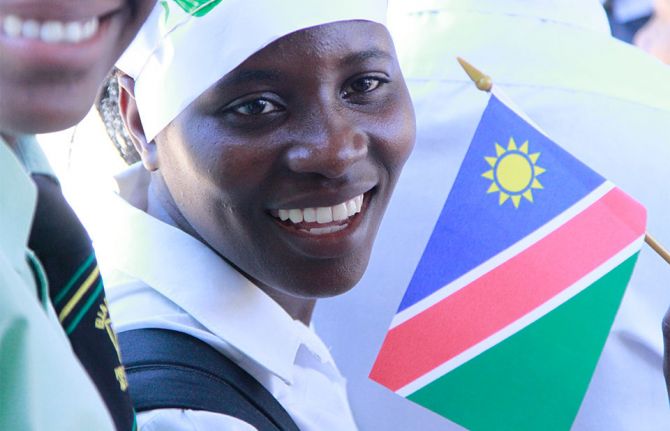
Press Statement
UNAIDS congratulates Namibia on increasing access to treatment
26 July 2018 26 July 2018Seventy-seven per cent of all adults living with HIV are virally supressed in Namibia
AMSTERDAM/GENEVA, 26 July 2018—UNAIDS welcomes new survey data showing that 77% of all adults living with HIV in Namibia are virally suppressed. The Namibia Population-Based HIV Impact Assessment (NAMPHIA) survey included 24 000 people from 0–64 years old. Participants were offered HIV counselling and testing as well as linkage to care and treatment for people who tested positive for HIV.
“Namibia’s concerted efforts to reach people with HIV testing and treatment are producing extraordinary results,” said Michel Sidibé, Executive Director of UNAIDS. “UNAIDS will continue to support Namibia in reaching all people living with HIV with testing and treatment and in boosting Namibia’s HIV prevention efforts to further bring down new HIV infections.”
NAMPHIA was a widespread household HIV survey funded by the Government of the United States of America and conducted by the Centres for Disease Control and Prevention, Columbia University and local government and nongovernmental partners from June to December 2017.
UNAIDS
The Joint United Nations Programme on HIV/AIDS (UNAIDS) leads and inspires the world to achieve its shared vision of zero new HIV infections, zero discrimination and zero AIDS-related deaths. UNAIDS unites the efforts of 11 UN organizations—UNHCR, UNICEF, WFP, UNDP, UNFPA, UNODC, UN Women, ILO, UNESCO, WHO and the World Bank—and works closely with global and national partners towards ending the AIDS epidemic by 2030 as part of the Sustainable Development Goals. Learn more at unaids.org and connect with us on Facebook, Twitter, Instagram and YouTube.

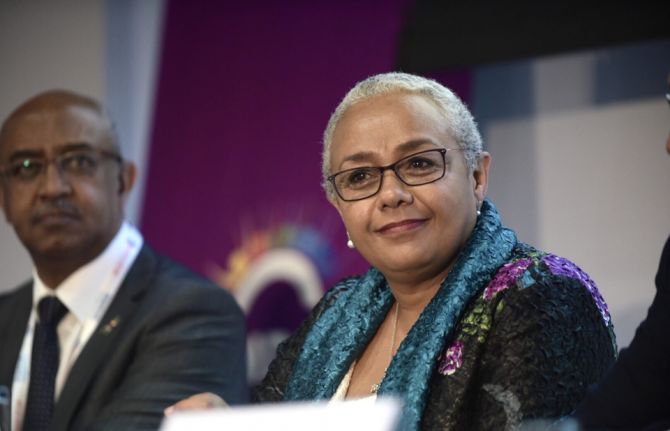

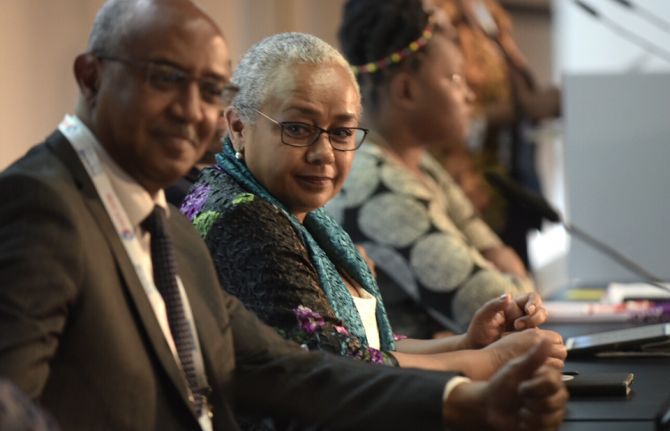
Feature Story
Kenya: leadership and innovation for results in eliminating mother-to-child transmission of HIV
26 July 2018
26 July 2018 26 July 2018A meeting at the 2018 International AIDS Conference, being held from 23 to 27 July in Amsterdam, Netherlands, has showcased how Kenya is responding to the challenges and opportunities on the way towards validation of the elimination of mother-to-child transmission of HIV in a high-burden context.
Building on the Start Free Stay Free AIDS Free framework, specific attention is being given in Kenya to ensuring access to treatment for children and adolescents living with HIV, while addressing inequities, particularly among adolescent girls and young women.
The participants heard about the role of high-level champions—including community leaders, parents, religious leaders and other relevant stakeholders—highlighting the need for action at all levels, based on robust programmatic data.
Kenya has made significant progress in preventing new HIV infections among children, which fell from an estimated 13 000 in 2010 to 8000 in 2017. This has been possible through programmes such as the mentor mother initiative, which supports and cares for women living with HIV, the mother–baby pair approach, which synchronizes appointments for the mother and the child at the health facility, and audits of every child exposed to HIV in order to identify barriers in accessing health facilities.
The leadership of Margaret Kenyatta, the First Lady of Kenya, and her Beyond Zero Campaign have been instrumental in raising awareness on the importance of services to promote the health of mothers and children, including HIV prevention.
The participants heard, however, that more needs to be done to ensure that progress is equal across the country. Progress has been threatened by recent challenges, such as a health workers strike, which has affected antenatal care and testing coverage, and reduced community support, which has affected demand creation for HIV services.
The participants decided that there was an urgent need to scale up HIV programmes. This would be complemented by innovations in tracking the targets for paediatric and adolescent HIV and accounting for every mother and child. Furthermore, the resilience of the health system needs to be strengthened.
The meeting, held on 24 July, was jointly organized by the Ministry of Health of Kenya, UNAIDS and the Elizabeth Glaser Pediatric AIDS Foundation.
Quotes
“As I reflect on the great gains Kenya has made, what is worrying in the last few years is the widening gap in terms of increased infections among adolescents, especially among young women. The challenges of some of the efforts made, for women especially, mean that our investments in eliminating mother-to-child transmission of HIV may be wiped out in two decades.”
“Every child has the right to be born free from HIV. And every child living with HIV should receive life-saving treatment to stay AIDS-free. And every young person should be supported to stay free from HIV. We cannot leave any child or mother behind.”
“Adopting innovations, such as point-of-care HIV testing with nearly immediate results, is critical to support us young women living with HIV to access the services we need. Programmers and service providers need to listen to our needs and concerns.”
“Progress shown by the data from Homa Bay, Kenya, to reduce new paediatric infections is a powerful message from the highest prevalence county in one of the highest burden countries. If we can do it in Homa Bay, we can do it anywhere.”
Region/country
Related

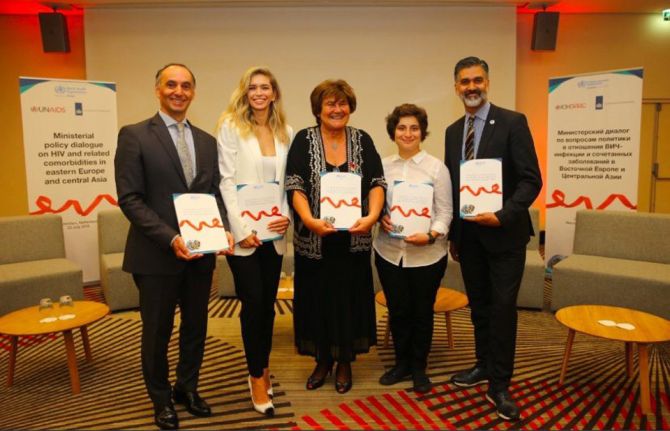
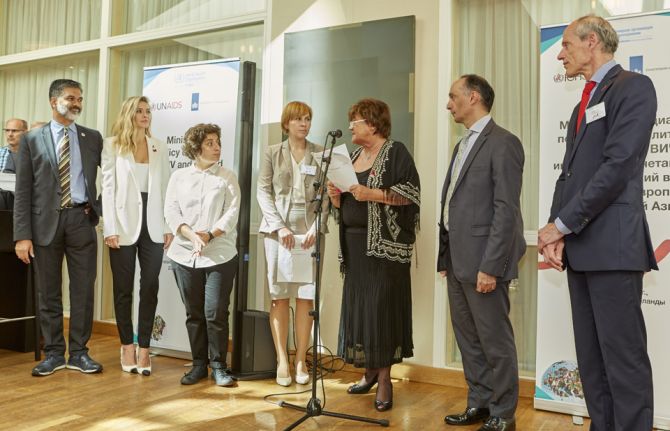
Feature Story
Health leaders from 10 countries in eastern Europe and central Asia reaffirm commitment to scale up the AIDS response
24 July 2018
24 July 2018 24 July 2018Ministers of health and senior policy-makers from 10 countries in eastern Europe and central Asia reaffirmed their political commitment to scale up national HIV responses during a ministerial policy dialogue on HIV, which was held on the eve of the International AIDS Conference in Amsterdam, Netherlands.
The participants exchanged their experiences and the results of their national AIDS responses with a view to adapting them and scaling them up across the region. They discussed the Fast-Track priorities for achieving the 90–90–90 targets, whereby, by 2020, 90% of people living with HIV will know their HIV status, 90% of people who know their HIV-positive status will be accessing treatment and 90% of people on treatment will have suppressed viral loads. The Fast-Track priorities include the scale-up of domestic funding, the continued focus on key populations, strengthening collaboration across sectors and working in partnership with civil society and people living with HIV.
According to the recent UNAIDS report Miles to go, in eastern Europe and central Asia the annual number of new HIV infections has doubled since 2010—one of the only regions of the world in which HIV continues to increase.
Stigma and discrimination discourages HIV testing and treatment uptake. Harm reduction services remain essential in a region where nearly one third of new HIV infections are among people who inject drugs. Harm reduction programmes are in place across the region, but often at a limited scale.
At the end of 2017, among the 1.4 million people living with HIV in eastern Europe and central Asia, 73% were aware of their HIV status, an increase from 69% in 2016. A majority of the countries in the region have officially adopted test and treat, but owing to resource constraints and barriers to treatment among key populations, the pace of treatment scale-up is slow and coverage remains among the lowest in the world. About 520 000 people were accessing antiretroviral therapy in 2017, just 36% of all people living with HIV in the region.
During the dialogue, the Compendium of good practices in the health sector response to HIV in the WHO European region, featuring 52 successful examples from 32 countries, was launched.
The dialogue was organized by the World Health Organization Regional Office for Europe and UNAIDS, in cooperation with the Government of the Netherlands.
Quotes
“The time to accelerate our efforts is now. We have done much, but we have not done it all. When there are evidence-based approaches to change the course of the HIV epidemic in our region, we cannot afford business as usual.”
“We need ministers of health to convince heads of state and government to meet with people living with HIV and support key populations in order to set an example on how to end stigma and discrimination.”
“I am impressed to see an unprecedented number of ministers of health here at the International AIDS Conference. Let’s maintain this momentum after Amsterdam to get public leaders in your countries to enhance the momentum to reverse the HIV epidemic in countries across eastern Europe and central Asia.”
“Young people across eastern Europe and central Asia are calling on ministers of health to engage and empower young people in all aspects of policy development and implementation.”
“An inclusive rights- and evidence-based HIV response is cost-effective. At today’s dialogue here in Amsterdam, with the unprecedented participation of health ministries, experiences were exchanged and results discussed. Let’s use good practices as an example and scale them up to ensure an effective and inclusive response.”
Region/country
- Eastern Europe and Central Asia
- Albania
- Armenia
- Azerbaijan
- Belarus
- Bosnia and Herzegovina
- Bulgaria
- Croatia
- Cyprus
- Czechia
- Estonia
- Georgia
- Hungary
- Kazakhstan
- Kyrgyzstan
- Latvia
- Lithuania
- Montenegro
- Poland
- Republic of Moldova
- Romania
- Russian Federation
- Serbia
- Slovakia
- Slovenia
- Tajikistan
- North Macedonia
- Türkiye
- Turkmenistan
- Ukraine
- Uzbekistan

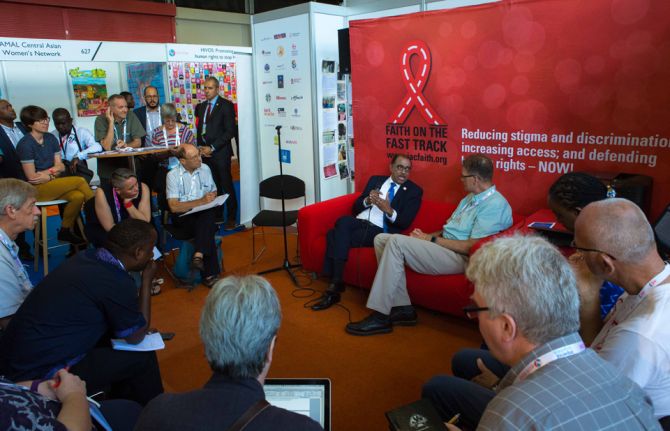
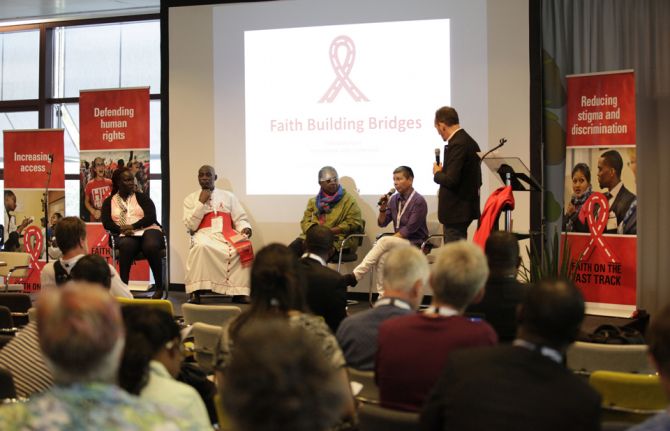
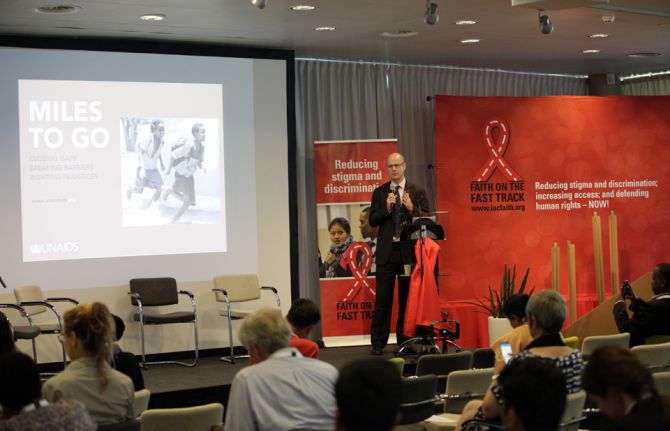
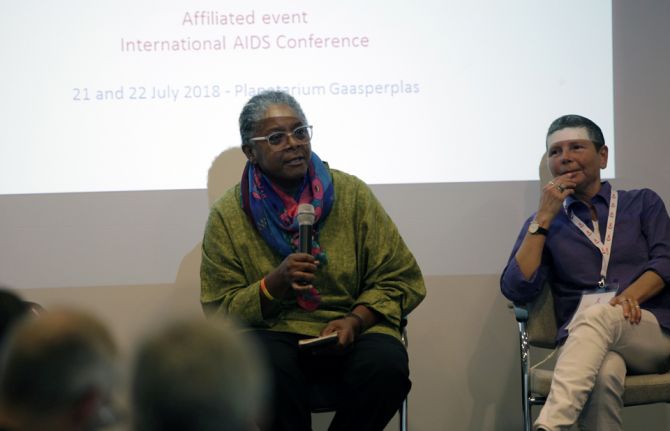
Feature Story
Faith communities building bridges
24 July 2018
24 July 2018 24 July 2018Faith Building Bridges, the interfaith pre-conference event that was held before the International AIDS Conference, ended on 22 July. The participants joined together in a common voice to demand that the world recommit to ending AIDS and that world leaders take strong actions now, and in the future, to ensure that the AIDS epidemic is brought to an end.
Some 150 representatives of faith-based organizations, religious leaders, health-care providers, activists, policy-makers and other stakeholders attended Faith Building Bridges, which was convened by the World Council of Churches–Ecumenical Advocacy Alliance. Sessions included migration and how it puts people at risk of HIV infection, role of faith groups in ending TB, as well as how faith communities can strategically support children and adolescents living with HIV.
At the closure of Faith Building Bridges, faith activities transitioned to the faith networking zone in the Global Village, where UNAIDS Executive Director Michel Sidibé engaged faith leaders in a lively dialogue on 24 July. He focused on the critical role of faith communities as champions of social justice to help eliminate HIV-related stigma and discrimination.
Commemorating friends who died from AIDS-related illnesses and expressing hope and solidarity, people of diverse faiths came together in an interfaith prayer and memorial service on 23 July at the Keizersgrachtkerk in Amsterdam.
People of faith marched in solidarity with other conference delegates from the interfaith prayer service to the International AIDS Conference, expressing solidarity and commitment to the global response to HIV.
An interfaith networking zone in the Global Village will include events focusing on the importance of religious leadership in promoting HIV testing, testing and treatment for children and adolescents, addressing tuberculosis and HIV coinfection and strengthening interfaith responses to HIV.
Quotes
“No one can help us more than the church in overcoming stigma. This is your natural terrain, fighting for social justice.”
“Hope should be seen as a human right in our world today.”
“We are here at this International AIDS Conference and we come as those carrying a banner of hope and a banner of possibility for all of those in the world.”
“We have an opportunity to continue the transformative impact of faith. Diversity has to inform our debate and our actions.”
Related

Feature Story
Young people call on the world to #UPROOT the causes that put them at risk of HIV
24 July 2018
24 July 2018 24 July 2018The PACT, a global coalition of youth organizations working on HIV and sexual and reproductive health and rights, gathered in Amsterdam, Netherlands, on 24 July at the International AIDS Conference, a year after launching #UPROOT, a youth-led political agenda to end AIDS by 2030.
The session saw youth advocates share materials developed by #UPROOT to inspire and mobilize more young people to act at the country level to challenge harmful laws, advocate for youth participation in the AIDS response and build strategic and more resilient partnerships to end AIDS.
Discussions focused on persisting legal barriers that young people face to access services, including age of consent laws on HIV testing and treatment. In 2017, 73% of 125 countries reported having age of consent requirements for HIV testing, out of which 31% require consent for adolescents younger than 18 years old. The PACT, through the #UPROOT agenda, has developed a set of policy briefs aimed at youth advocates to tackle these legal and policy constrains to access services.
Young people’s participation in the HIV response was highlighted as a key determinant to ensure its effectiveness and sustainability. Youth participation in key decision-making spaces is still a challenge. A recent UNAIDS report, Youth and HIV: mainstreaming a three-lens approach to youth participation, suggests that “while young people participate in the development, consultation, validation or review of strategic documents that guide the HIV response at the country level, they participate much less frequently in spaces where decisions are made about the policy framework or resources invested in the HIV response.”
Greater technical and financial support to young people’s participation in community responses to HIV was also highlighted as a pending need of youth-led organizations and networks working on HIV.
Strengthening collaboration between medical students and young key populations to reform national medical curricula in order to tackle discrimination in health care was also a focus of the session. In 2017, under the #UPROOT agenda, the International Federation of Medical Students Associations signed a memorandum of understanding with youth organizations and networks, including networks of young key populations and young people living with HIV, to respond to discrimination in health care, resulting in stronger collaborations in several countries, including Egypt and Uganda.
All the resources developed by the #UPROOT agenda thus far, including guidance on youth organizing, advocacy and accountability in advancing the AIDS response and young people’s rights, will soon be available on an online action centre.
Quotes
“The #UPROOT agenda is grounded in young people’s frustration at being left behind in the HIV response, but also highlights our hope and optimism that by working together and tackling the underlying systemic issues that keep us at risk, we can change things for the better.”
“In this day and age, it is unacceptable that adolescents and young people still struggle to access HIV and sexual and reproductive health services. The world has the money, the know-how but unfortunately not the political will to end AIDS. We need to #UPROOT the barriers that hinder political will.”
“We have a global discrimination epidemic, and it is one of several root causes that keep putting young people at risk of HIV infection and AIDS-related deaths. The end of AIDS is possible, but we have miles to go to ensure that everyone, everywhere, has access to services and is treated with dignity and respect.”
Related
 “Who will protect our young people?”
“Who will protect our young people?”

02 June 2025

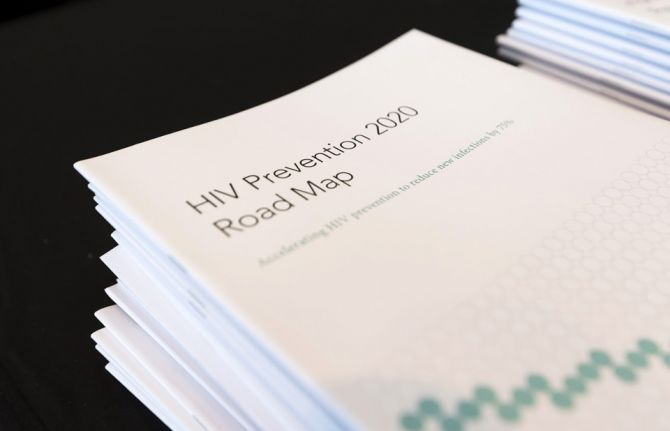
Press Statement
At AIDS 2018, UNAIDS calls for bold leadership to tackle the prevention crisis
24 July 2018 24 July 2018UNAIDS warns that countries urgently need to take proven, tailored, evidence-informed primary HIV prevention programmes to scale in addition to increasing access to treatment.
AMSTERDAM/GENEVA, 24 July 2018—UNAIDS is urging countries to take bold action to address the HIV prevention crisis. Around 1.8 million people became newly infected with HIV in 2017 and around 50 countries experienced a rise in new HIV infections as HIV prevention services are not being provided on an adequate scale or with sufficient intensity.
“Health is a human rights imperative and we are deeply concerned about the lack of political commitment and the failure to invest in proven HIV programmes, particularly for young people and key populations,” said Michel Sidibé, Executive Director of UNAIDS. “If countries think they can treat their way out of their epidemics, they are dangerously mistaken.”
UNAIDS’ newly released report, Miles to go: closing gaps, breaking barriers, righting injustices, shows that 47% of new HIV infections globally are among key populations. Although combination HIV prevention approaches work for key populations, including harm reduction, pre-exposure prophylaxis (PrEP), social care and condoms, many countries are unwilling to invest in approaches viewed as culturally or religiously inappropriate, unpopular or counter to the bad laws that may exist in a particular country.
HIV prevalence can be high as up to 70% among sex workers in some southern African countries; however, about three quarters of countries reporting to UNAIDS criminalize some aspect of sex work and sex workers report that condoms are often confiscated by the police.
In eastern Europe and central Asia, one third of all new HIV infections are among people who inject drugs; however, 87% of countries reporting to UNAIDS criminalize drug use or possession of drugs, driving people underground and out of reach of HIV services. Many countries do not make sterile injecting equipment and opioid substitution therapy widely available, which is a huge barrier to efforts to bring down new HIV infections among this population and their partners.
Gay men and other men who have sex with men accounted for around 57% of new HIV infections in western and central Europe and North America in 2017 and an estimated 41% of new infections in Latin America. However, globally, access to HIV services for men who have sex with men is still being blocked by bad laws. Of 100 countries reporting to UNAIDS, at least 44 had laws specifically criminalizing same-sex sexual intercourse. The death penalty applied in two countries.
“If countries don’t provide comprehensive sexuality education, condoms, harm reduction or pre-exposure prophylaxis for key populations, this will ultimately translate into more new HIV infections, higher future treatment costs and a higher burden for health-care budgets and systems,” said Mr Sidibé.
Countries that have invested are seeing results. In Finland’s capital, Helsinki, for example, scale-up of harm reduction and HIV testing and treatment services led to a steep drop in new HIV infections and high rates of viral suppression among people who inject drugs. The number new HIV diagnoses in this key population decreased from more than 60 in 1999 to almost zero in 2014.
In San Francisco, United States of America, PrEP was added to programmes that include HIV testing, rapid linkages to antiretroviral therapy and boosting support for retention in care. Between 2013 and the end of 2016, there was a 43% decrease in new HIV diagnoses in the city, a decline that is being attributed to both quicker achievement of viral suppression among people who test HIV-positive and to increased uptake of PrEP.
Women and girls also need access to HIV prevention. In 2017, around 6500 women and girls were infected with HIV every week. Limited access to education, a lack of economic autonomy and a lack of decision-making power, including over their own health, expose them to intimate partner violence, limit their ability to practise safer sex and limit their ability to benefit from HIV and sexual and reproductive health services, making them more vulnerable to HIV infection.
Women and girls must have the knowledge and power to protect themselves against HIV in safe and enabling environments and must be able to access services that meet their needs. This requires countries to reform discriminatory laws that perpetuate inequality and develop and enforce laws that promote gender equality.
Young people also need age-appropriate youth-friendly health services. More than two thirds of countries reporting to UNAIDS require parental consent for a child under 18 years to access HIV testing, and more than half require consent for HIV treatment.
While most countries have significantly scaled up their HIV treatment programmes, some to the extent of reaching 80% of people living with HIV with antiretroviral therapy, the HIV prevention benefits of treatment that countries had hoped to achieve are not yet being realized. People are are not being diagnosed and treated soon enough, allowing transmissions to occur before they start treatment or if treatment is interrupted.
Botswana, for example, has nearly reached its 90–90–90* targets, as 86% of people living with HIV know their HIV status, 84% of people who know their status are on antiretroviral therapy and 81% of people on antiretroviral therapy are virally supressed. However, new HIV infections have failed to see any declines since 2010.
To urgently address the HIV prevention crisis and increase political commitment for HIV prevention, a Global HIV Prevention Coalition of United Nations Member States, donors, civil society organizations and implementers was established in 2017 that includes the 25 highest HIV burden countries.
The overarching goal of the Global HIV Prevention Coalition is to strengthen and sustain political commitment for primary HIV prevention by setting a common agenda—the HIV Prevention 2020 Road Map—among key policy-makers, funders and programme implementers to accelerate progress towards reducing new HIV infections by 75% by 2020.
On 23 July 2018, the Global HIV Prevention Coalition came together at an event at the International AIDS Conference in Amsterdam, Netherlands, to discuss the urgency for scaling up HIV prevention, share progress made and address persisting challenges, including policy barriers and inadequate financing for HIV prevention.
The Global HIV Prevention Coalition recently launched its first progress report, Implementation of the HIV Prevention 2020 Road Map, which shows that while initial progress has been made, more efforts are needed to move from political commitment to strong actions on the ground.
* 90% of people living with HIV know their HIV status, 90% of people who know their status are receiving antiretroviral treatment and 90% of people on treatment have suppressed viral loads.
For more information on the HIV prevention crisis, go to unaids.org.
UNAIDS
The Joint United Nations Programme on HIV/AIDS (UNAIDS) leads and inspires the world to achieve its shared vision of zero new HIV infections, zero discrimination and zero AIDS-related deaths. UNAIDS unites the efforts of 11 UN organizations—UNHCR, UNICEF, WFP, UNDP, UNFPA, UNODC, UN Women, ILO, UNESCO, WHO and the World Bank—and works closely with global and national partners towards ending the AIDS epidemic by 2030 as part of the Sustainable Development Goals. Learn more at unaids.org and connect with us on Facebook, Twitter, Instagram and YouTube.
Press centre
Download the printable version (PDF)

